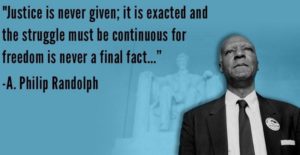5 Amazing Facts Younger Generations May Not Know About This Civil & Labor Rights Hero
Thousands of people use Washington, D.C.’s historic Union Station every day, but few notice an important statue of a leading civil and labor rights figure located in the main train concourse outside of the Starbucks. That statue belongs to A. Philip Randolph, one of the most visible faces in the long national struggle for civil rights.
Despite his significant contributions to the civil rights and labor movement, younger people may not even know him. They, however, owe what they might have taken for granted to this man because he led a successful campaign against racial discrimination in the workplace. After Randolph and his fellow civil rights activists threatened to hold a March on Washington in 1941, President Franklin D. Roosevelt issued Executive Order 8802 prohibiting racial discrimination in the national defense industry and government. It was the first federal action to prohibit employment discrimination in the United States.
Randolph continued to play a leading role in our nation’s civil rights and labor movement until his death in 1979. He remains an inspiration for us all with the principles he spoke of that day: empowering the powerless, challenging authority, and never faltering in the hardest of times; for it is the hardest of times that forge the greatest of people. Phillip Randolph would have turned 129 on April 15, 2018.
AFGE salutes his legacy with these five important facts about this important man:
1. His statue tells the story of the start of his heroic career.
When people realize Randolph was a civil and labor rights leader, they often wonder why his statue is located at Union Station. The location of this significant statue may seem surprising, but in fact it is not. Randolph’s career as a civil rights organizer took off in 1925 when he founded the Brotherhood of Sleeping Car Porters (BSCP) and was elected its first president. BSCP, one of the first labor unions led by black Americans, was instrumental in the advancement of the civil rights movement. Back then the Pullman Company expected their train porters to work extra hours with no overtime pay under poor working conditions at a time of widespread racial discrimination. In 1937, the BSCP won an increase in wages, shorter work hours, and overtime pay for its workers, making it the first black union to successfully negotiate a contract with a major company.
2. He helped end segregation in the armed forces.
FDR’s executive order prohibited racial discrimination in the defense industry, but racial discrimination in the armed forces did not actually end. In 1942, Randolph and his fellow civil rights activists kicked off a campaign to end segregation in the military, labor unions, government agencies and others at Madison Square Garden where 18,000 black Americans gathered to hear him speak. In 1947, they formed the Committee Against Jim Crow in Military Service, later renamed the League for Non-Violent Civil disobedience. When President Harry S. Truman asked Congress for a peacetime draft law, Randolph urged black men not to register. Truman needed the support of the growing black population, so he gave in to Randolph’s demand and issued Executive Order 9981 ending racial segregation in the military.
3. His March on Washington led to the passage of Civil Rights Act of 1964.
Randolph was the lead organizer of the historic March on Washington for Jobs and Freedom on Aug. 28, 1963. Randolph and his fellow civil rights leader Bayard Rustin came up with a plan two years earlier and began reaching out to labor unions and allies. Martin Luther King Jr. was one of the organizers and speakers, giving the historic “I Have a Dream” speech on the steps of the Lincoln Memorial. With an estimated 250,000 participants, it was one of the largest political rallies in the U.S. history. The march is credited with helping to pass the Civil Rights Act of 1964.
4. He was an important ally to Dr. King.
In the 1950’s and 60’s, Randolph formed an alliance with Dr. Martin Luther King, Jr. in the fight to desegregate schools, secure voting rights, and secure a brighter economic future for millions of oppressed African American citizens. Randolph organized the Prayer Pilgrimage for Freedom with Dr. King. He also organized Youth Marches for Integrated Schools in Washington, DC.
5. He founded a magazine, used to be in theatre.
Randolph was raised in New York City and grew up during World War I, where he became interested in populist literature and began studying the history of class struggle. With his friend Chandler Owen, he went on to found The Messenger, a pioneering political and literary magazine written by African American writers. A few years earlier, Randolph helped organize the Shakespearean Society in Harlem where he played the roles of Hamlet, Othello, and Romeo, among others.
Want to honor and spread the word about this great labor and civil rights leader? Share it on social media like Facebook and Twitter.





Leave a Reply
You must be logged in to post a comment.